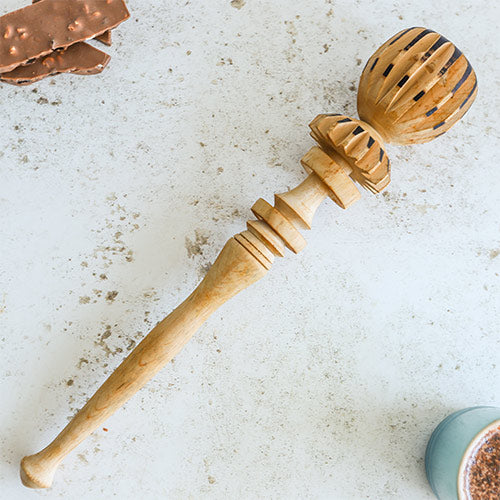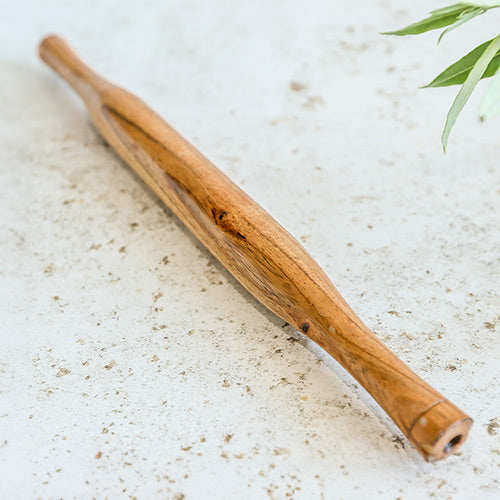Chapatis, roti, and flatbread are essential components of many Indian and South Asian cuisines. These tasty and versatile breads are traditionally made by hand, using a rolling pin to shape the dough into thin, circular flatbreads.
The type of rolling pin you choose can greatly influence the texture, thickness, and overall quality of the chapatis. In this article, we will examine the differences between two popular options—the chapati roller and the joint roller—and assist you in deciding which one best meets your chapati-making needs.Understanding the Different Types of Rolling Pins
Chapati Roller
A chapati roller, a bean, is a specialized rolling pin designed to make chapatis. It typically has a tapered, cylindrical shape and is often made of wood or stainless steel. The tapered design allows for easier control and even rolling the Dough, resulting in perfectly round and evenly thin chapatis.
Common Roller
On the other hand, a standard roller is a more versatile rolling pin that can be used for various baking tasks, including rolling out Dough for chapatis. These rollers typically have a straight, cylindrical shape and are available in multiple materials, such as wood, plastic, or marble.
Pros and Cons of Using a Chapati Roller
When evaluating the pros and cons of using a chapati roller, several factors come into play. On the positive side, the specialized design of a chapati roller, with its tapered shape, is engineered to facilitate the easy rolling of even, round chapatis, providing improved control and precision for achieving the desired thickness and shape.
This design also ensures consistent results, yielding chapatis with a professional and uniform appearance. However, there are some limitations to consider. Chapati rollers are primarily intended for making chapatis, making them less versatile for other baking tasks, such as rolling out pie crusts or cookie dough. Depending on the material and surface finish, chapati rollers may be prone to sticking, which can complicate the rolling process. Finally, chapati rollers can be more expensive than common rollers, especially when opting for high-quality, durable models.
Pros and Cons of Using a Common Roller
When considering the use of a common roller for chapatis, there are both pros and cons to keep in mind. On the positive side, common rollers offer versatility, as they can be used for various baking tasks, including rolling out chapati dough, pie crusts, and cookie dough. They are also generally more widely available and affordable compared to specialized chapati rollers. Additionally, many people are already familiar with using a standard roller, which can make the transition to chapati-making smoother.
However, there are drawbacks. A common roller's straight, cylindrical shape may make it difficult to achieve consistent thickness and shape in chapatis. The tapered design can lead to uneven rolling, making it challenging to produce uniformly rolled chapatis. Furthermore, using a common roller for chapati-making may require more effort and attention than a specialized chapati roller to achieve the desired results.
Factors to Consider When Choosing a Rolling Pin for Chapatis
When choosing a rolling pin for chapatis, consider a few key factors. First, think about the intended use: a chapati roller is ideal for making chapatis, while a standard roller offers versatility for other baking tasks. Your skill level also matters, as beginner bakers may find a chapati roller easier to control, whereas experienced bakers can achieve good results with a standard roller.
If the appearance of your chapatis is a priority, a chapati roller typically provides more uniform, round, and evenly thin results. Budget is another factor, as chapati rollers tend to be more costly than common rolling pins. Lastly, consider the material and durability of the rolling pin, as these affect both longevity and ease of use.
Tips for Using a Chapati Roller Effectively
To prepare perfect chapatis, start by kneading the dough thoroughly to achieve the right consistency. Lightly flour both the work surface and chapati roller to prevent sticking. As you roll, apply gentle, even pressure for a consistent thickness and rotate the dough frequently to help maintain a round shape. Adjusting the roller's angle as you work can also help you find the most comfortable and effective technique for achieving ideal results.
Tips for Using a Common Roller for Chapatis
To ensure consistent chapatis, start by dividing the dough into equal portions before rolling, which helps maintain uniform thickness across each piece. Begin rolling from the center and work outwards, using gentle, even strokes to shape the dough. Regularly flipping and rotating the dough aids in achieving an even thickness and round shape.
When using a standard roller, apply a lighter touch, as its straight design can make it challenging to control the thickness precisely. Additionally, consider using a chapati board or other flat surface, which can help produce more consistent results with a standard roller.
Comparing the Results of Chapati Roller vs Common Roller
When comparing the results of using a chapati roller versus a common roller, there are some notable differences. The chapati roller generally produces a more consistent and even thickness, while a common roller can result in uneven thickness. In terms of shape, chapatis made with a chapati roller tend to be perfectly round, whereas the common roller may produce less uniform shapes.
Texture-wise, the chapati roller delivers a smoother, more delicate finish, while the common roller often leaves a slightly coarser texture. Rolling with a chapati roller also requires less effort, making it easier to use than a common roller. Finally, chapatis made with a chapati roller have a more professional and uniform visual appeal, while those made with a common roller may appear less polished.
Popular Chapati Rollers and Traditional Rolling Pins

When it comes to choosing a rolling pin, there are some popular brands and models to consider for both chapati rollers and common rollers. For chapati rollers, options like the Preethi, Wonderchef, Butterfly, Prestige, and Vinod rollers are well-regarded for their quality and performance.
If you're looking for a versatile rolling pin, you might explore choices like the OXO Good Grips Rolling Pin, the Marble Rolling Pin by Joseph Joseph, the Wooden Rolling Pin by Farberware, the Silicone Rolling Pin by Wilton, or the Stainless Steel Rolling Pin by KitchenAid. Each of these options offers its unique features, making them suitable for various baking needs.
You can shop for a chapati rolling pin here.
Chapati Rolling Pin (Frequently Asked Questions)
Can I use a joint roller to make chapatis?
Yes, you can use a joint roller to make chapatis, but you may need to put more effort into achieving the desired results. A chapati roller is designed for this task and can make the process easier and more efficient.
Is a chapati roller only for making chapatis?
No, a chapati roller can be used for a variety of other baking tasks, such as rolling out Dough for rotis, parathas, and even some types of pastries. However, it is primarily designed for chapati-making.
How do I clean a chapati roller or joint roller?
For both types of rolling pins, it's best to wipe them down with a damp cloth after use. Avoid submerging them in water, which can damage the wood or other materials. Occasionally, you may need a mild soap and water solution to remove stubborn dough residue.
Can I use a rolling pin with bearings to make chapatis?
While rolling pins with bearings can provide a smooth and effortless rolling experience, they may not be the best choice for making chapatis. The tapered design and lack of bearings in a traditional chapati roller or joint roller can be more effective in achieving the desired texture and shape for chapatis.
Based on the information in this article, I recommend considering a chapati roller if your primary focus is making delicious, evenly rolled chapatis. Its specialized design and better control can help you achieve consistent, professional-looking results. However, if you need a more versatile rolling pin for a variety of baking tasks, a common roller may be a better fit. Whichever option you choose, be sure to follow the tips provided for using it effectively. Happy chapati-making!
Up Next: Sri Lankan Roti Recipe










